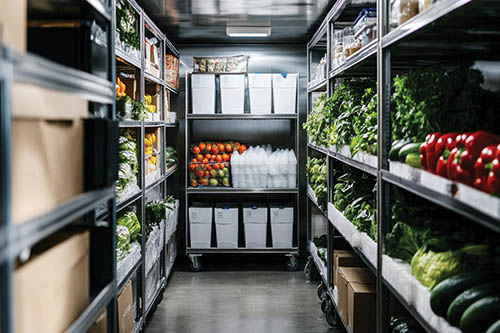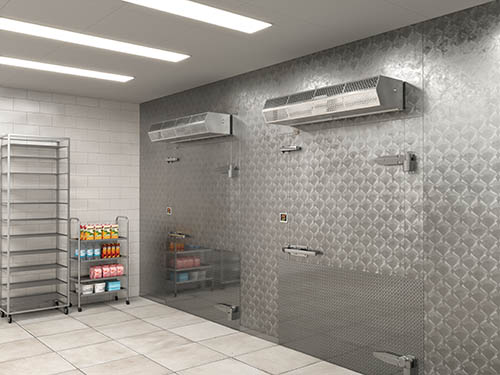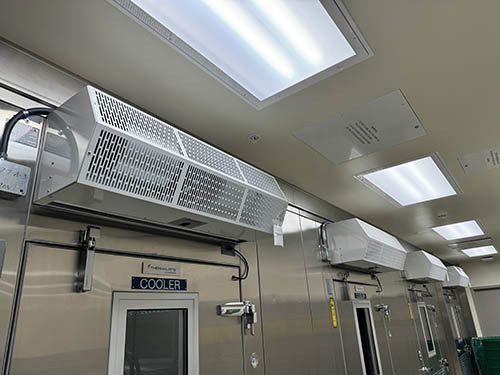— By Steve Benes —
Designing a smarter barrier strategy for your walk-in cooler with air curtains.
Walk-in coolers are critical for restaurants and cafeterias to store perishable goods, but they also contribute significantly to energy consumption. To maintain consistent low temperatures, walk-in coolers run continuously with little to no relief. Research from the National Renewable Energy Laboratory (NREL) suggests that refrigeration accounts for about 20% of the total energy use in restaurants, making it a major driver of utility costs. Every time the cooler door is opened, warm air rushes in, forcing the compressor to work harder and run longer. Larger walk-ins or those with insufficient insulation further amplify this strain, as more energy is needed to maintain low temperature requirements.1 This infiltration of warm air disrupts temperature stability, increases energy use, and impacts food quality and safety.
Restaurant owners are under increasing pressure to protect their inventory, safe working environments and profit margins. Wholesale food costs are up 35% compared to 2020,2 and electricity costs are expected to continue to rise faster than the rate of inflation this year.3 Improving the effectiveness of the barriers at walk-in cooler entryways can help control costs and promote a safe, healthy environment for restaurant employees and customers.

Traditional barrier techniques including automatic doors and vinyl strip curtains offer some protection for cold storage areas, but each solution has its own limitations in meeting demanding performance and hygiene requirements. Air curtains, which are devices that are installed above entrances to blow a controlled stream of air downward, can correct weak points in existing cooler barriers or offer an added barrier of protection instead of allowing full infiltration.
Increasing the efficiency of walk-in cooler environments for restaurants requires effective environmental separation. Air curtains, as a standalone solution or a complement to other barrier technologies, can help restaurants comply with energy efficiency building codes, maintain stable refrigerator temperatures, and improve ease of use and access to these walk-in-coolers.
Cold Storage Challenges

Since 2009, the Energy Policy and Conservation Act (EPCA) has mandated that walk-in coolers include some form of infiltration-minimizing protection, such as vinyl strip curtains, spring-hinge doors or automatic door closers.4 In practice, some of these methods can prove frustrating for employees who frequently enter and exit walk-in coolers. Staff may tie back vinyl strips for convenience or leave doors open for prolonged periods, which undermines their effectiveness. Warmer temperatures near the door of the cooler can put food at risk for spoilage due to condensation or frost buildup, while also leading to increased compressor cycling and higher energy usage.
For walk-in cooler areas, barrier solutions must be designed to fit the needs of the restaurant’s daily operations while forming a proper air barrier that effectively separates environments.
Creating an Active Air Barrier
Patterns of air movement are affected by both temperature and moisture. Air with a higher moisture content, which is typically the warm restaurant kitchen, wants to move to the drier, dehumidified space within the walk-in cooler.
While strip curtains impede multidirectional airflow by creating a seal or pass-through wall of PVC strips, air curtains use a controlled air stream to create an invisible air barrier that limits the exchange of warm and cold air. The result is less moisture entering the cooler, reduced loss of conditioned air leading to more stable temperatures, and lower compressor run times and maintenance issues.
Design Flexibility for Restaurant Realities
Each restaurant environment is unique. Whether installed during new construction or as part of a retrofit, air curtains can be customized to meet the unique needs of each walk-in unit and restaurant environment. The width and direction of the air stream is customized for each cooler. What makes an air curtain effective is not simply how fast the air moves, but how the air is controlled. Each unit, installation and calibration is tailored to the size of the entryway and the operational dynamics of the building.
For new builds, some walk-in cooler manufacturers include air curtains in their construction specifications, understanding their ability to enhance cooler efficiency from the outset.

For existing locations, air curtains can be installed above doorframes and can supplement doors and strip curtains already in use, offering upgraded performance without the need for significant renovations. They support integration with door sensors and switches, enabling them to activate only when doors are open and automatically shut off when they close.
In restaurants, the airflow is fine-tuned to account for pressure differentials created by exhaust hoods, loading docks, exterior doors and HVAC systems. If the cold space has a negative pressure, strip curtains can help manage space pressure while air curtains provide added protection and moisture management. When the strip curtain is closed, the air curtain helps reduce condensation buildup on the PVC strips. When the strip curtain opens, the air curtain’s barrier takes over, maintaining environmental separation.
Tangible Results
Air curtains deliver measurable benefits for walk-in coolers by helping maintain stable interior temperatures. This stability translates into reduced compressor run times, which can reduce utility bills and equipment maintenance costs. Real-world testing has shown that air curtains can reduce compressor runtime by up to 27%, cutting operating hours while preserving the integrity of refrigerated food. With less strain on refrigeration systems and a lower risk of food spoilage due to temperature fluctuations, air curtains protect product shelf life, increase equipment efficiency, and support food safety compliance.
In an industry where margins are tight and operating costs can be unpredictable, walk-in cooler optimization is essential. Coolers are critical for safe, efficient kitchen operations, yet they represent one of the largest sources of energy consumption and equipment wear. While the most effective way to save energy is to keep the cooler door closed, the practical solution is to add an air curtain that fits the height and width of the entryway. Addressing infiltration while ensuring usability, compliance and food safety requires more than a one-size-fits-all environmental separation solution. By enhancing door effectiveness and improving air movement within the cooler, air curtains ultimately help restaurant operators control costs, conserve energy and protect profitability.
Notes:
1 National Renewable Energy Laboratory. https://www.osti.gov/servlets/purl/1435907
2 National Restaurant Association. https://restaurant.org/research-and-media/research/restaurant-economic-insights/economic-indicators/food-costs/
3 U.S. Energy Information Administration. https://www.eia.gov/todayinenergy/detail.php?id=65284
4 U.S. Department of Energy. https://www.energy.gov/eere/buildings/articles/issuance-2016-12-28-energy-conservation-program-energy-conservation-0
— Steve Benes is the national sales director at Berner International, overseeing the U.S. and Canadian regions.

